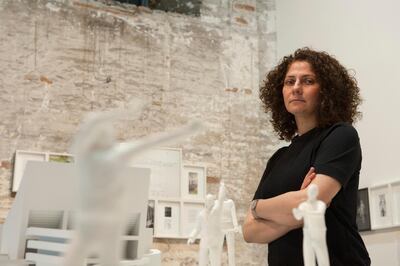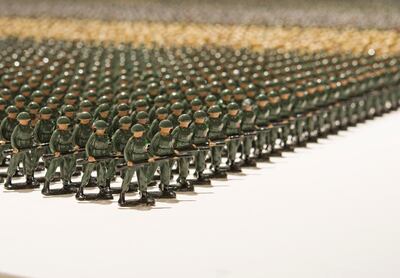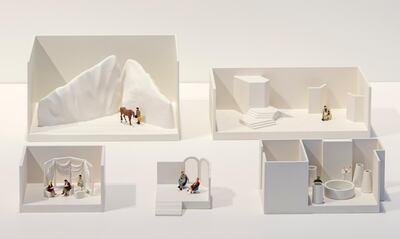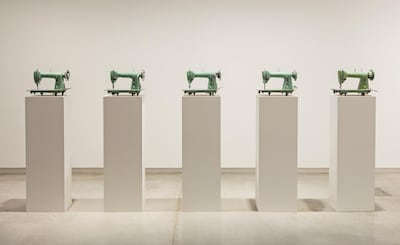Just after Ala Younis's show opened at Sharjah Art Foundation, the artist and the exhibition's curator, Ryan Inouye, spoke to me of a generational divide: younger artists and curators who feel removed from history or, as Inouye put it, feel "history has very little to do with them". By contrast, Younis's work is rooted in key moments of the Arab 20th century, such as the Palestinian cause, former president of Egypt Gamal Abdel Nasser's pan-Arabism, and the Lebanese Civil War. They attempt to understand how the political situation in the Middle East has affected the daily lives of its people – in ways that can only be perceived in retrospect.
Steps Toward the Impossible is an in-depth solo show by the Kuwaiti-born Jordanian artist. Younis's work reveals history through a wide-angle view, and often through its connections to mass culture. She reveals links between the 1967 Arab-Israeli conflict and television tropes, between sewing machines that kept breaking down and Arab nationalism, or tin soldiers and the facts about Arab states' military capacities.

Perhaps because she is sometimes known as a "research artist" – someone for whom a work's backstory takes precedence over the formal artwork itself – for this exhibition, she and Inouye put the artworks themselves in the foreground, going light on the documentation that often accompanies her installations. As a result, it prompts questions that are rarely asked of Younis's practice. Instead of thinking of militancy, feminism, architecture, or decolonisation – her typical research areas – I started thinking of notions of scale, positions of omniscience, the odd empathy of objects and even the strange feeling of being disproportionately colossal among children's toys – a goddess among men.
Younis is fond of the small-scale model. In Tin Soldiers (2011), an installation of 12,261 hand-painted toy troops, she represents the standing Arab armies as of 2010, with each toy figure representing 200 soldiers. They are arranged into neat lines on a white plinth that supports their combined weight of 250 kilograms – "or five persons like me," says Younis.

There are some surprises for those who aren't military watchers: the size of Turkey's army, for example, or the per capita slenderness of Israel's. They comprise an alternate map of the Middle East: a quantified understanding of what might happen should there be a regional war.
"I'm interested in showing the larger picture," says Younis, a woman whose apparent seriousness slides easily into amiability. "It's something you could not see otherwise in its totality, you only hear it in numbers. Now I know it, others can see it as well."
Similarly, for the new piece Drachmas (2018), Younis made small dioramas of famous Arab TV programmes of the 1960s to 1980s, such as Raafat El Haagan and Alo Hayati. She took screen grabs of key scenes and sent them to the production team at Sharjah Art Foundation. Initially thinking they would 3D-print the figures, the foundation's team ended up sending them to model-makers (the 3D prints weren't precise enough). The tiny models have the same hand-painted quality of the tin soldiers. Spread out as if in a mini city of staggered plinths, they force the viewer into a position of voyeurism, peering commandingly into several interrupted scenes at once.

Drachmas shows how the TV programmes mapped shifting social issues among the Arab states. These include support for the Palestinians, and later, the diversity of national populations once the Palestinian diaspora became permanent. It also looks at the rise of social conservatism and the kidnappings and instability which came out of Lebanon's civil war. Plot points and themes in the shows reflected these political currents and those currents in turn affected the production of the series.
Younis explains: "In 1978, when Egypt signed the peace treaty with Israel, the Arab states boycotted Egyptian state productions.
"That was great for the actors because they were very popular – no one could do without them, so they could travel and work in other countries' series and be paid in hard currency. And for Egypt to clean its name among the Arabs and reclaim its position as a leader of the Arab world, they started to produce these series of espionage, about secret agents who tricked Israel into doing good for Egypt."
__________________________
Read more:
Sharjah's Focal Point: First artists' book fair comes to emirate
Jameel Arts Centre: here's what to expect from Dubai Creek's new cultural space
How Sheikha Hoor Al Qasimi brought new life to Sharjah's arts scene
__________________________
"Around this time, you see numerous scenes with lie-detector machines," she says, pointing to a small diorama where an inch-tall man is hooked up to a machine the size of a fingernail. "That was something the whole Arab world was fascinated with. Or you press a door and something slides and there's a hidden machine."
"And here," she says, pointing to a model peering through a transom, "you have a grandmother looking over her sons and daughters so she can hear their private lives."
Bathed in millennial-pink light, the delicate, precise installation feels unusual for an art context. Younis trained as an architect, and these works bring to mind architectural models – a source that was fully apparent in her well-known installations about a Le Corbusier-designed gymnasium in Baghdad: Plan for Greater Baghdad and Plan (fem.) for Greater Baghdad. They also reflect a trend towards items of material culture as ways to examine histories that are often excluded from official narratives – such as that of the domestic sphere.
Younis began her Nefertiti project when she came across the eponymous (now-defunct) sewing machines in Cairo's Friday Market. Once she realised what they were, she kept going back to find more, even though the traders wanted to sell her sewing machines that actually worked. Younis was determined, though. "The information about these machines was never written down in terms of social analysis, but when you meet people, they all know that women at home had them," she says. "For me, they are emblems of Nasser's project to make a modern state – and of the industrial projects that did not give us what they promised us."

Little by little, Younis found more information about the machines. They were fully produced in Egyptian factories, from the needles to the spinning wheels. Women would pay the equivalent of Dh5 a month to use them in their homes. During the 1967 conflict, Egyptian singer and actress Umm Kulthum bought machines for the families of martyrs so they could support themselves. But there were no spare parts available, and once the markets opened up after Nasser passed away, the Nefertiti machines stopped being used.
Younis stands these machines in five plinths in the space, where they attain an industrial beauty, with their tapering curves, painted coats of military green and stylised Arabic lettering reading “Nefertiti”. They’ve been rescued, almost literally, from the dustbin of history.
These objects, and the pop culture moments she represents, give a three-dimensionality to the past – which at times includes the artist herself. Later, she points out a vignette in Drachmas from when her life intersected with that of the TV stars. "My family went on a holiday to Athens in the late '80s and we stayed at the President Hotel, where the cast and crew from an Egyptian series happened to be staying," she says. "Here I am pressing all the buttons in an elevator, being screamed at by a Greek chef, and I'm saying: 'I don't understand you, I did not press these buttons!'
“All the while my family is taking a photo of my sister posing next to an Egyptian actress in the lobby.”
I couldn’t help thinking of the figurine of the little Younis while walking around the show. We are all the mini-Younis’s, but she wants us to be the beings peering overhead.
Ala Younis: Steps Toward the Impossible is at Sharjah Art Foundation until January 5, 2019






